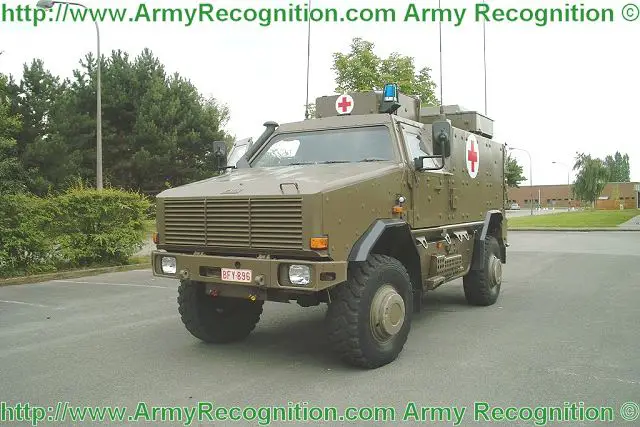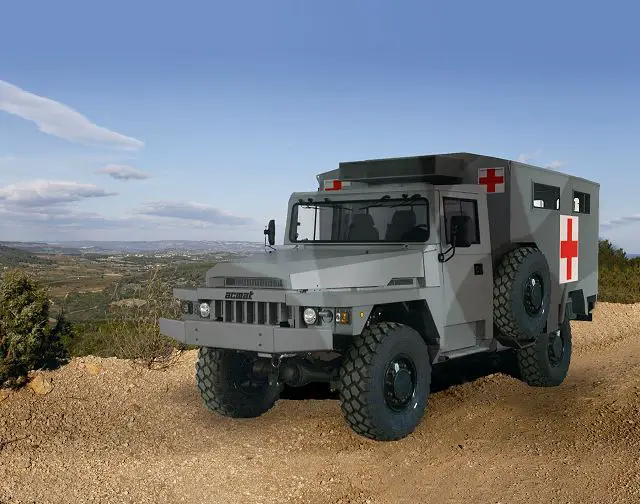| a | |||
Military ambulance on the battlefield |
|||
| Saturday, April 14, 2012, 07:00 PM | |||
| Acmat light tactical vehicles for medical support and ambulance on the battlefield. | |||
| In order to save soldier lives on the battlefield, medical units need to provide advanced care on the field and evacuate wounded personnel to a hospital as quickly as possible. Those are the two critical elements. Time is a crucial factor, and medical care needs to be provided continuously along the entire evacuation process. To accomplish their mission medical units must have suitable ambulance for the modern battlefield. Military ambulances include both ambulances based on civilian designs and armored, but unarmed ambulances based on wheeled armoured personnel carriers (APCs) such as the Dingo 2, VRLA TPK Acmat or the M113 tracked armored vehicle. (By Alain Servaes Chief Editor Army Recognition) |
|||
 Dingo 2 ambulance of Belgian army |
|||
With
missions evolving for some armed forces, the choice has been made to give
up tracked armoured vehicles in favor of wheeled vehicles which require
less maintenance and can be more easily deployable by aircraft. Today,
medical service should be available all the time, and that means they
must be able to provide emergency treatment and surgical capabilities
on the battlefield. Fast evacuation is another very important factor,
the injured soldier should be evacuated as soon as possible, most of the
time by helicopter but the alternative is the light tactical ambulance
or medical support armoured vehicle. All medical military units in the world try to improve evacuation by introducing armoured or tactical vehicles which have the same level of mobility and protection as other combat vehicles. The new medical support vehicle must be able to treat and evacuate combat casualties from combat and support units on the 21st Century battlefield, while providing a standard of care similar to that in other modern medical evacuation vehicles and aircraft. There are two types of vehicles used by military medical units, the light tactical vehicle that is used to quickly transport the wounded soldiers on the battlefield. That type of vehicle is often equipped with stretchers and has no medical support equipment. The French Defence Company ACMAT propose an ambulance variant in its range of VLRA TPK vehicle. The VLRA TPK ambulance is modified VLRA TPK that can carry 4 to 6 injured soldiers to medical centres and base camps. The layout of the VLRA TPK ambulance is conventional, with the engine at the front, crew compartment at the centre and the medical shelter at the rear. The cab can be equipped with soft doors and soft top on request. The use of the standard chassis of VLRA TPK ensures the same mobility in all terrain for ambulance version which is able to follow the combat vehicles in all conditions. Based on 60 years of military experiences, the VLRA TPK has already shown its combat and operational capabilities during many past and present conflicts all over the world. |
|||
 VLRA TPK 425 4x4 ambulance version |
|||
Field
medical units are under the command of the combatant Commanders, because
their movements and work must be coordinated with those of fighting forces.
To ensure these missions of medical support to the combatants, medical
units must be able to follow the units fighting on the modern battlefield.
This means that they must be equipped with vehicles which have the same
level of protection as the standard fighting vehicle.
Today all combat vehicles
are faced with three main threats, IED's, rockets and firing of small
arms. Improvised Explosive Devices (IEDs) were identified by survey
respondents as being the most potent and important threat to protect
against over the next ten years. The modern military ambulance vehicles
must also be able to withstand against this new threats. |
|||
 The VLRA TDN/TDE ACMAT ambulance version guarantee a highly mobile and protected medical transport for current and future missions on modern battlefield. |
|||
The VLRA TDN-TDE or BASTION ambulance version guarantee a highly mobile and protected medical transport for current and future missions on modern battlefield. With a weight below 11.000 kg, the VLRA TDN-TDE and Bastion are easily transportable by air and sea which makes it also a unique solution for rapid deployment in humanitarian missions or peacekeeping. |
|||
Acmat light tactical vehicles for medical support and ambulance on the battlefield 1404121
- Posted On














